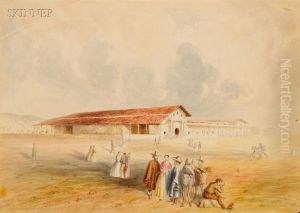Harrison Gilman Eastman Paintings
Harrison Gilman Eastman was an American artist and engraver, known for his works depicting the landscapes and burgeoning urban environment of California during the 19th century. Born in 1823 in Concord, New Hampshire, Eastman developed an interest in art at a young age. His initial artistic training is not well-documented, but it is known that he moved westward, like many others of his time, drawn by the allure of new opportunities.
Eastman settled in California during the Gold Rush period and was one of the first artists to capture the San Francisco Bay Area and the quickly changing landscapes of the West. He was particularly adept at engraving, a skill that allowed him to reproduce his works and those of others for broader dissemination. His engravings are valuable records of the era's architecture, townscapes, and daily life.
Throughout his career, Eastman worked on a variety of projects, including creating illustrations for books and magazines, which would become historical documents of the era’s culture and development. In addition to his prints and engravings, Eastman also produced watercolors and oil paintings. Notably, he was involved in the production of some of the earliest pictorial lettersheets, which were popular during the Gold Rush and provided visual news to people back East about life in California.
Harrison Gilman Eastman's contribution to the visual history of California is significant. His works serve as an important chronicle of the transformation of the American West during the mid to late 19th century. He passed away in 1906, leaving behind a legacy of art that continues to offer insights into the past and is collected and studied by historians and art enthusiasts alike.
